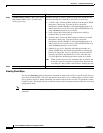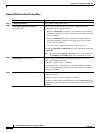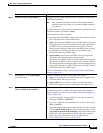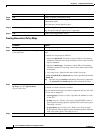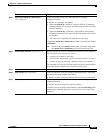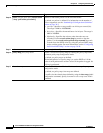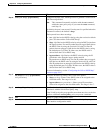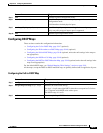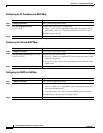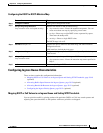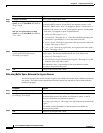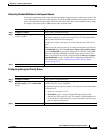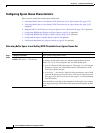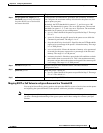
38-46
Cisco IE 2000 Switch Software Configuration Guide
OL-25866-01
Chapter 38 Configuring Standard QoS
How to Configure Standard QoS
Creating Aggregate Policers
By using an aggregate policer, you can create a policer that is shared by multiple traffic classes within
the same policy map. However, you cannot use the aggregate policer across different policy maps or
ports.
You can configure aggregate policers only in nonhierarchical policy maps on physical ports.
Step 19
service-policy input policy-map-name Specifies the VLAN-level policy-map name, and applies it to the SVI.
Repeat the previous step and this command to apply the policy map to
other SVIs.
If the hierarchical VLAN-level policy map has more than one
interface-level policy map, all class maps must be configured to the
same VLAN-level policy map specified in the service-policy
policy-map-name command.
Step 20
end Returns to privileged EXEC mode.
Command Purpose
Command Purpose
Step 1
configure terminal Enters global configuration mode.
Step 2
mls qos aggregate-policer
aggregate-policer-name rate-bps burst-byte
exceed-action {drop |
policed-dscp-transmit}
Defines the policer parameters that can be applied to multiple traffic
classes within the same policy map.
By default, no aggregate policer is defined. For information on the
number of policers supported, see the
“Standard QoS Configuration
Guidelines” section on page 38-5.
• aggregate-policer-name—Specifies the name of the aggregate
policer.
• ate-bps—Specifies average traffic rate in bits per second (b/s).
The range is 8000 to 1000000000.
• burst-byte—Specifies the normal burst size in bytes. The range
is 8000 to 1000000.
• Specifies the action to take when the rates are exceeded. Use the
exceed-action drop keywords to drop the packet. Use the
exceed-action policed-dscp-transmit keywords to mark down
the DSCP value (by using the policed-DSCP map) and to send
the packet.
Step 3
class-map [match-all | match-any]
class-map-name
Creates a class map to classify traffic as necessary.
Step 4
policy-map policy-map-name Creates a policy map by entering the policy map name, and enters
policy-map configuration mode.
Step 5
class class-map-name Defines a traffic classification, and enters policy-map class
configuration mode.
Step 6
police aggregate aggregate-policer-name Applies an aggregate policer to multiple classes in the same policy
map.
• aggregate-policer-name—Enters the name specified in Step 2.



